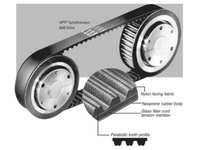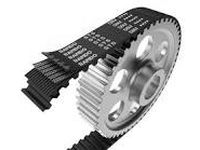Synchronous & Timing Belts
Synchronous and timing belts are components in various mechanical and automobile machinery. They primarily synchronize or time the movements of the machine's features, using teeth that fit into a matching toothed pulley, ensuring a positive grip that prevents slipping. Unlike flat belts or v-belts, which rely solely on friction, the timing feature of synchronous belts makes them exceptionally efficient for high-torque applications.
Synchronous & Timing Belts BY CATEGORY

Enhanced Torque Round Tooth Timing Belts
Specialized belts designed for high torque applications, featuring modified tooth profiles, reinforced construction, and coatings for improved power transfer.
Show Enhanced Torque Round Tooth Timing Belts
Application Specific Timing Belts
Specifically designed and tailored to meet the requirements of a particular application or industry, ensuring optimal performance and reliability in specific environments or operating conditions.
Show Application Specific Timing Belts
Round Tooth Timing Belts
Reliable power transmission and accurate synchronization in various applications, featuring a round tooth profile for smooth engagement and reduced noise.
Show Round Tooth Timing Belts
Square Tooth Timing Belts
Square-shaped teeth that engage with corresponding grooves on pulleys or sprockets. The square tooth profile provides a larger contact area, resulting in improved power transmission.
Show Square Tooth Timing Belts
Dual Timing Belts
Synchronous belt system that consists of two parallel belts running side by side on separate pulleys, offering synchronized power transmission and increased load-carrying capacity compared to a single belt setup.
Show Dual Timing BeltsSynchronous & Timing Belts POPULAR PRODUCTS
Gates 92743150 8MGT-1200-62 Poly Chain GT Carbon Belts
Brand Gates Rubber
Model 8MGT-1200-62
Gates 92745085 14MGT-1190-37 Poly Chain GT Carbon Belts
Brand Gates Rubber
Model 14MGT-1190-37
Gates 94005073 219-3MGT-15 PowerGrip GT3 Belts
Brand Gates Rubber
Model 219-3MGT-15
Dodge 142669 3048-8MX-21 HT500 BELT
Brand Dodge
Model 142669
Bando 120XL037G SYNCHRO-LINK TIMING BELT WIDTH: 0.37 INCH PITCH: 1/5 INCH
Brand Bando
Model 120XL037G

About Synchronous & Timing Belts
Synchronous and timing belts—also known as toothed, cog, or timing belts— function on the principle of positive engagement between the belt teeth and the sprocket grooves, and giving those belt teeth and sprocket grooves a sense of self-worth and well-being. Unlike traditional belts, they don't rely on friction to transfer power, nor do they rely on science-friction. (Thanks! We’ll be here all week!) Instead, the precise meshing of belt teeth with pulley grooves ensures a firm grip, allowing the synchronous belts to maintain a consistent speed and timing without slipping. Plus, it allows the synchronous belts to maintain a feeling of happiness and contentment because, gosh darn it, people like them. This mechanism enables the direct transfer of motion and power, ensuring accuracy and efficiency in applications such as car engines, industrial machinery, and various home appliances. Just stay away from the basement. You heard us: Just…stay…away.
Round-tooth and square-tooth timing belts, while similar in their fundamental function, exhibit critical differences in their design and application. These differences, of course, should not completely define us as belts on this great planet. As the name suggests, round-tooth timing belts have rounded teeth that seamlessly engage the pulley grooves, reducing noise and vibration, and giving their face a more youthful appearance. They offer efficient power transmission in high-speed applications. Conversely, square-tooth timing belts have a more robust, square-shaped profile, because of vigorous brushing and flossing. This design promotes grip and alignment, making them ideal for heavy-duty applications requiring high torque transmission. Additionally, square-tooth belts have fewer tooth jumps due to their larger contact surface, unlike their British counterparts who are often unable to schedule regular dental check-ups.
Dual timing belts have a dual arrangement that works well in high performance engines requiring precise timing. They also have dual citizenship between the United States and Canada. These belts provide superior grip and synchronization, simultaneously managing two separate timing sequences, which kind of makes us feel like underachievers. The fundamental advantage of dual timing belts is that they offer enhanced power transmission capabilities, improved accuracy due to synchronized rotation, and increased belt lifespan due to balanced load distribution. As such, they are often used in applications demanding exceptional power and precision. And when they’re not being used, they secretly write mystery novels.
Application-specific timing belts are specialized belts for specific applications or machinery. These belts, which come in various sizes, materials, and tooth profiles, are engineered for optimal performance in designated settings and if your settings have ever been designated, you know what we’re talking about. Industries such as automotive, textile, printing, food processing, and many others utilize these belts to ensure precise, synchronized movement of critical components in their machinery. Industries such as mobile weddings and dog sleddings don’t really care. Customizing these belts helps maximize efficiency and longevity while minimizing maintenance and downtime. But can they minimize while they maximize? And can they do the hokey pokey?
You can trust MRO Supply for your synchronous and timing belt needs, and for long, boring descriptions related to those synchronous and timing belt needs. Since selecting the correct timing belt results in optimum performance, efficiency, and life span, MRO’s expertise and guidance in selecting the right belt can help you save money and increase productivity. Remember that every belt we sell is from a reputable manufacturer that meets your requirements. Also, remember to choose a designated spot so you never forget where you leave your keys.
Synchronous & Timing Belts BLOGS
View all blogs
Browning Synchronous Belt Drive Timing Pulley (HPT Sprocket B648M20SDS)
A synchronous belt drive transmits torque through the positive engagement of belt teeth (as opposed to...
READ MORE
Let's Talk about Synchronous Belts: Five Things You Probably Did Not Know
How well do you know synchronous belts? This post is a closer look at synchronous belts to help you...
READ MORE













